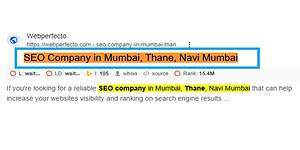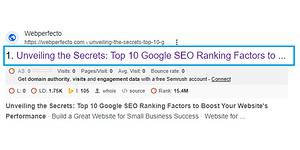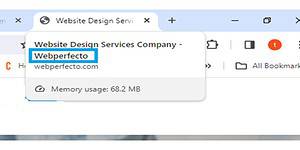What is Title Tag in SEO?
A title tag in SEO is a concise HTML element that defines a webpage’s title. It serves a dual purpose, acting as both a guide for search engines to understand the content and a display title for users in search results. This tag encapsulates the essence of a page, providing a brief, keyword-rich description that aids search engines in ranking and users in deciding whether to click. Crafting an optimized title tag involves strategically incorporating relevant keywords while maintaining readability. An effective title tag is a powerful tool for improving search engine rankings and increasing click-through rates, thus enhancing a website’s overall visibility.
HTML Structure of Title Tags
In HTML, the structure of title tags is straightforward. The title tag is enclosed within <title> and </title> tags. For instance:
The text between the <title> and </title> tags represents the title of your webpage. This title is crucial for search engines, providing them with essential information about the content. Crafting a clear and relevant title within the HTML structure contributes significantly to search engine optimization (SEO) efforts and helps users understand the purpose of your webpage
The Role of Title Tags in SEO
Title tags play a pivotal role in Search Engine Optimization (SEO), wielding a dual influence on both search engine rankings and user click-through rates.
Impact on Search Engine Rankings:
The content encapsulated within title tags is a key factor in search engine algorithms. Search engines utilize title tags to comprehend the relevance and context of a webpage. Crafting title tags with strategically placed keywords helps signal the content’s focus, contributing to higher rankings in search results.
Impact on Click-Through Rates:
Beyond SEO, title tags directly affect user behavior. When displayed in search results, a compelling and relevant title entices users to click through to the webpage. A well-optimized title tag can significantly boost click-through rates, driving more traffic to your site. Striking the right balance between SEO optimization and user appeal is essential for maximizing the impact of title tags on both fronts
How to Optimize Title Tag
Your title tag is like a digital handshake, the first point of contact between your content and search engines, making it a cornerstone of SEO strategy. you will learn how to optimize title tags, exploring the nuances of keyword selection, length considerations, and the overall craftsmanship required to ensure your titles not only rank well but also captivate and entice users in the competitive realm of search engine results.
Keyword-Rich Titles
A keyword-rich title acts as a beacon, guiding search engines to the core theme of your content. When users type queries into search engines, the presence of these keywords in your title significantly enhances the likelihood of your page being displayed in search results.
Relevant keywords in titles not only catch the attention of search engines but also serve as a crucial factor in user decision-making. Users often click on titles that directly mirror their search queries, making keyword-rich titles instrumental in increasing click-through rates.
The impact on SEO is profound. Search engines utilize complex algorithms to analyze the correlation between search queries and the content on web pages. A title embedded with relevant keywords signals to search engines that your content is directly related to the user’s query, boosting your page’s ranking.
However, the art lies in achieving a harmonious balance. While it’s essential to include relevant keywords, the title must remain clear, concise, and engaging for human readers. Keyword stuffing, or excessively cramming keywords into titles, can have adverse effects, leading to a decline in user experience and potential penalties from search engines.
Optimal Length and Format for Title Tags
Optimizing title tag length is crucial in the realm of SEO. Search engines display a limited number of characters for titles in search results, making it essential to craft concise yet informative titles. The ideal title tag length is around 50-60 characters to ensure it appears in full. This sweet spot allows for maximum visibility and readability, increasing the likelihood of users clicking on your content. Striking the right balance between providing relevant information and adhering to character limits not only enhances search engine rankings but also improves user experience, ultimately driving more traffic to your website.
This is example of shorter page title
Exceeding the ideal character count, typically around 50-60 characters, can have adverse effects on how your title appears in search engine result pages (SERPs). If titles are too lengthy, search engines may truncate them, displaying an incomplete version that fails to convey the full context. This truncation not only compromises the visual appeal but also hampers the effectiveness of your message.
This is an example of search engines truncating titles which longer than the ideal length of the title
- Keep your title as per Ideal length
- Use symbols like & instead of and . This technique will save your title space
- If you want to use two keywords in title tag then separate them with pipe(|)
USE Focus/ Primary Keyword
Using your focus keyword in the title tag is a fundamental SEO strategy. It signals search engines about your content’s relevance to specific queries, enhancing the likelihood of a higher ranking. A well-crafted title with the focus keyword not only improves visibility but also entices users to click through, driving organic traffic.
Avoiding Common Title Tag Mistakes
- Keyword Stuffing Pitfalls
Overloading titles with excessive keywords harms readability.
Search engines penalize for unnatural keyword density.
- Generic Titles and Lack of Uniqueness
Generic titles fail to distinguish your content in crowded search results.
Unique titles improve click-through rates and user engagement.
- Ignoring Ideal Length and Formatting
Titles exceeding the ideal character count may be truncated in search results.
Proper formatting enhances visual appeal and SEO effectiveness.
- Neglecting Mobile Optimization
Non-responsive titles diminish user experience on mobile devices.
Mobile-optimized titles ensure consistency across various screen sizes.
- Inconsistent A/B Testing
Lack of A/B testing misses opportunities for title optimization.
Regular experimentation refines strategies for maximum impact.
- Using Business Name in Title Tag
By avoiding the pitfalls associated with using a business name, you can create title tags that blend brand identity with SEO effectiveness.
How a Title Tag Beneficial for SEO ranking?
A well-optimized title tag is instrumental in boosting SEO rankings for several key reasons:
Relevance to Search Queries: Title tags containing relevant keywords signal search engines about the content’s alignment with user queries, enhancing visibility.
User Click-Through Rates: Engaging and descriptive title tags attract users, leading to increased click-through rates. Higher user engagement positively influences SEO rankings.
Search Engine Categorization: Title tags provide context for search engines to categorize and index content accurately, aiding in the retrieval of relevant results.
Algorithmic Considerations: Search engine algorithms consider title tags as a primary factor when determining the relevance and quality of webpages, impacting overall ranking.
Enhanced User Experience: Clear and concise title tags improve the user experience by delivering accurate expectations, reducing bounce rates, and signaling quality content to search engines.
In essence, an optimized title tag is a fundamental component of SEO, contributing significantly to a webpage’s visibility, user engagement, and ultimately, its ranking on search engine results pages.





